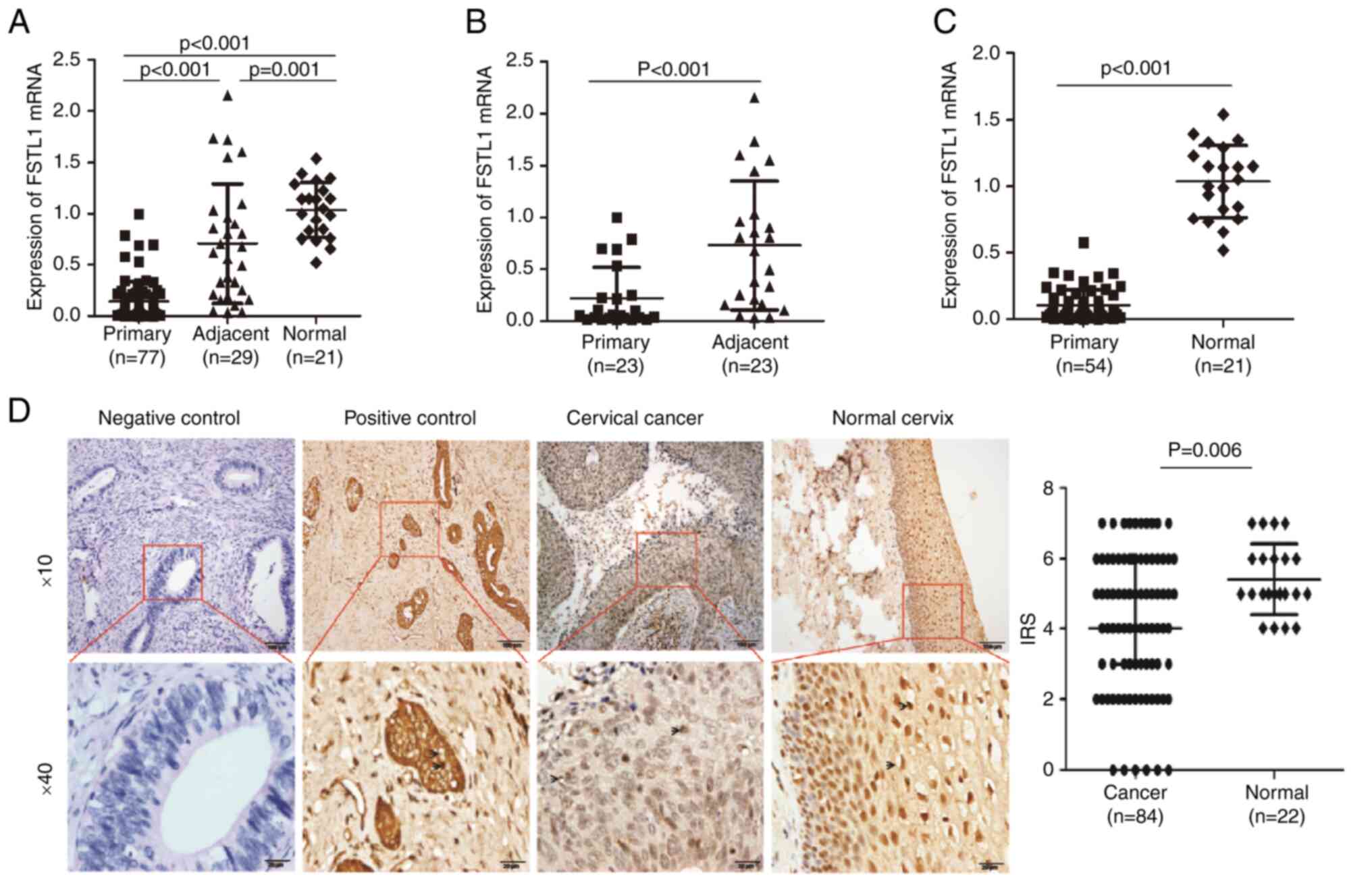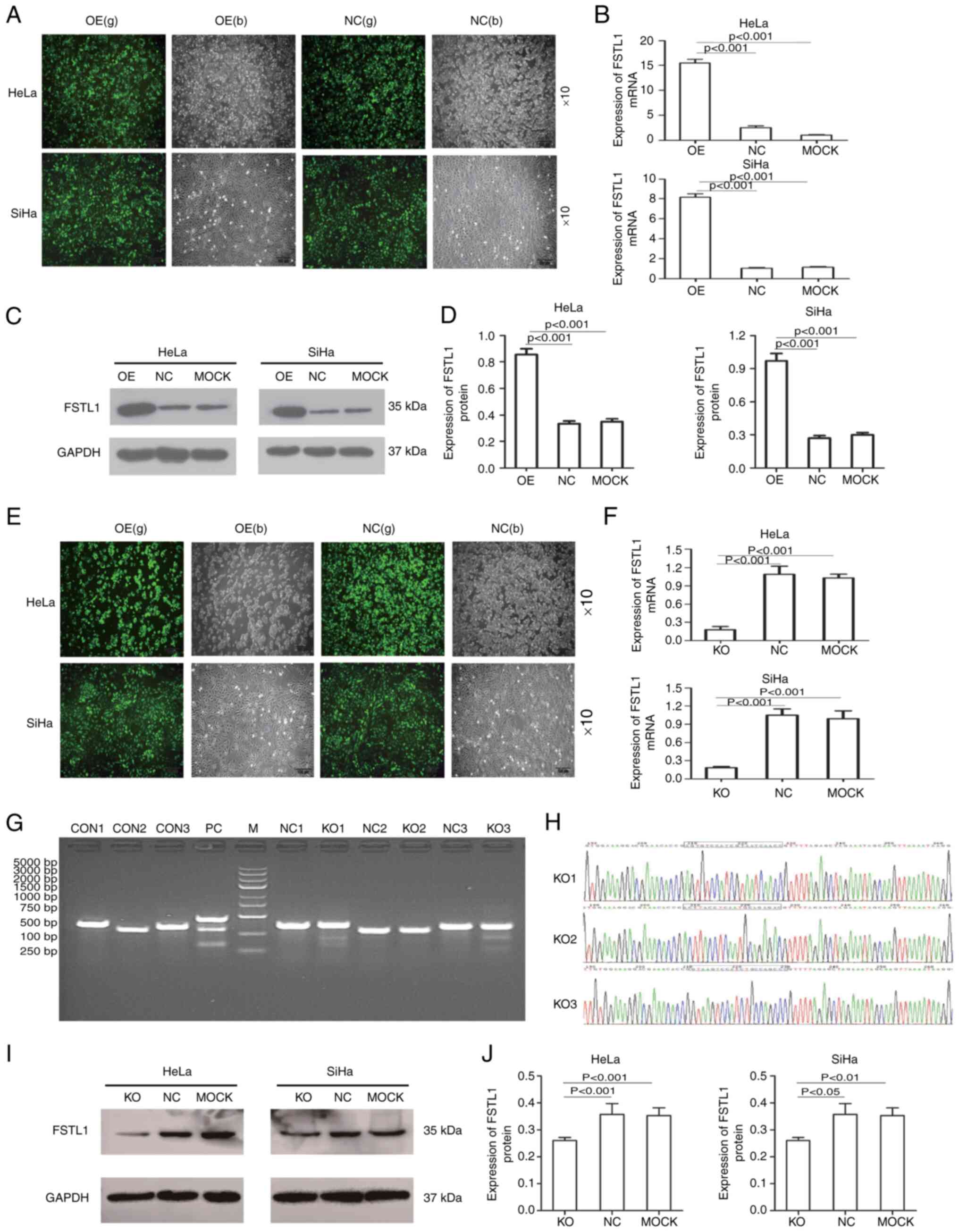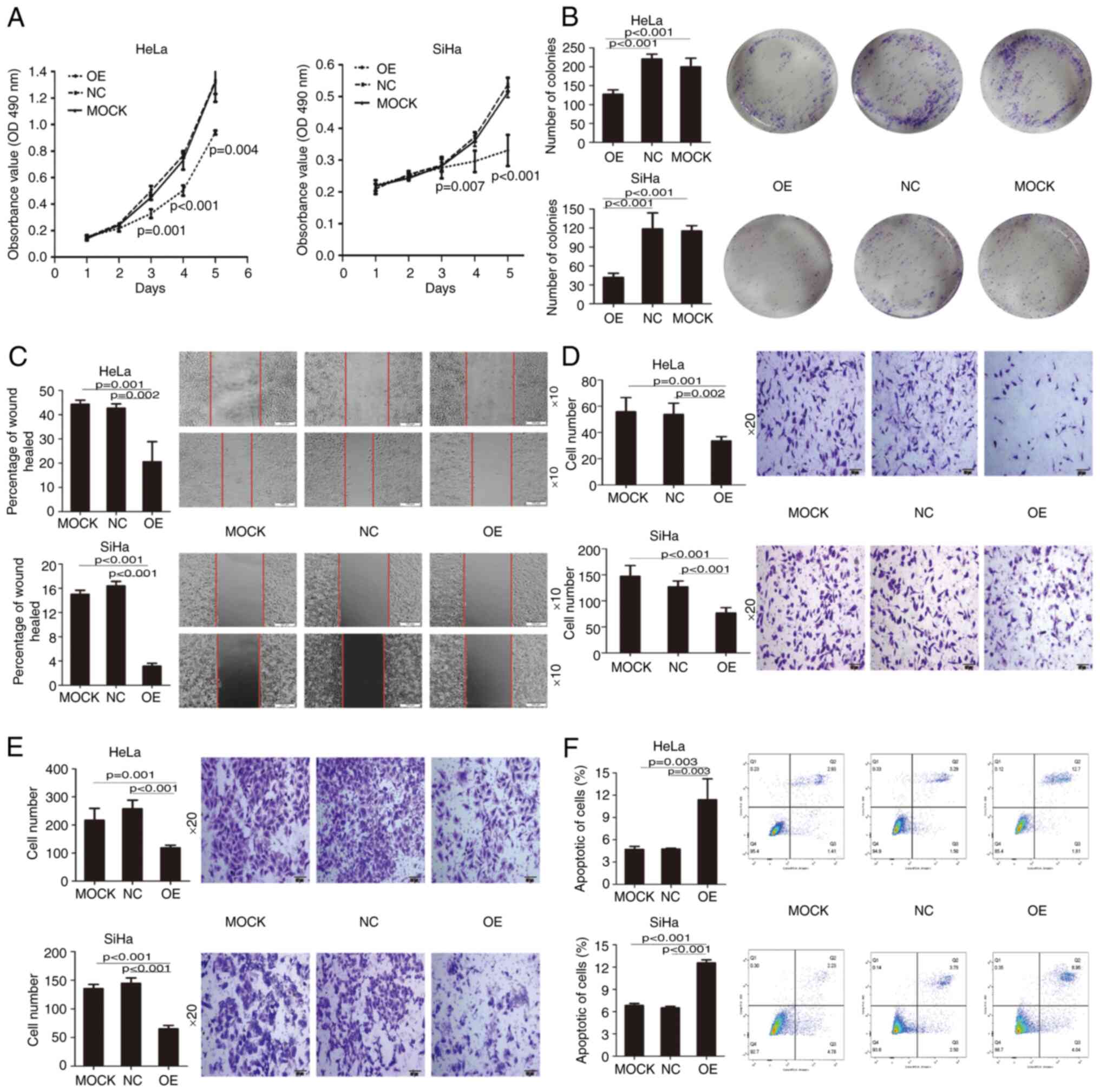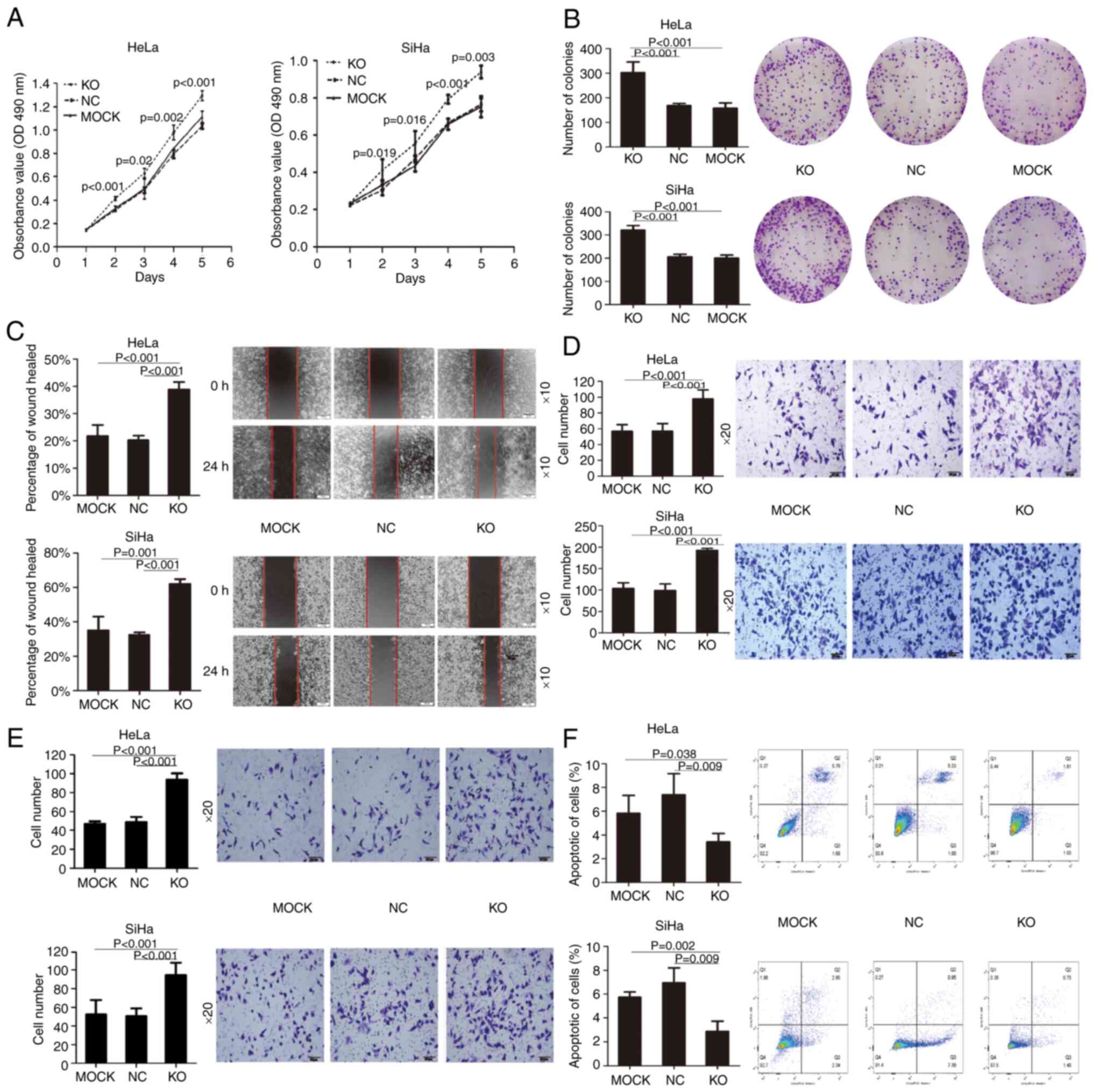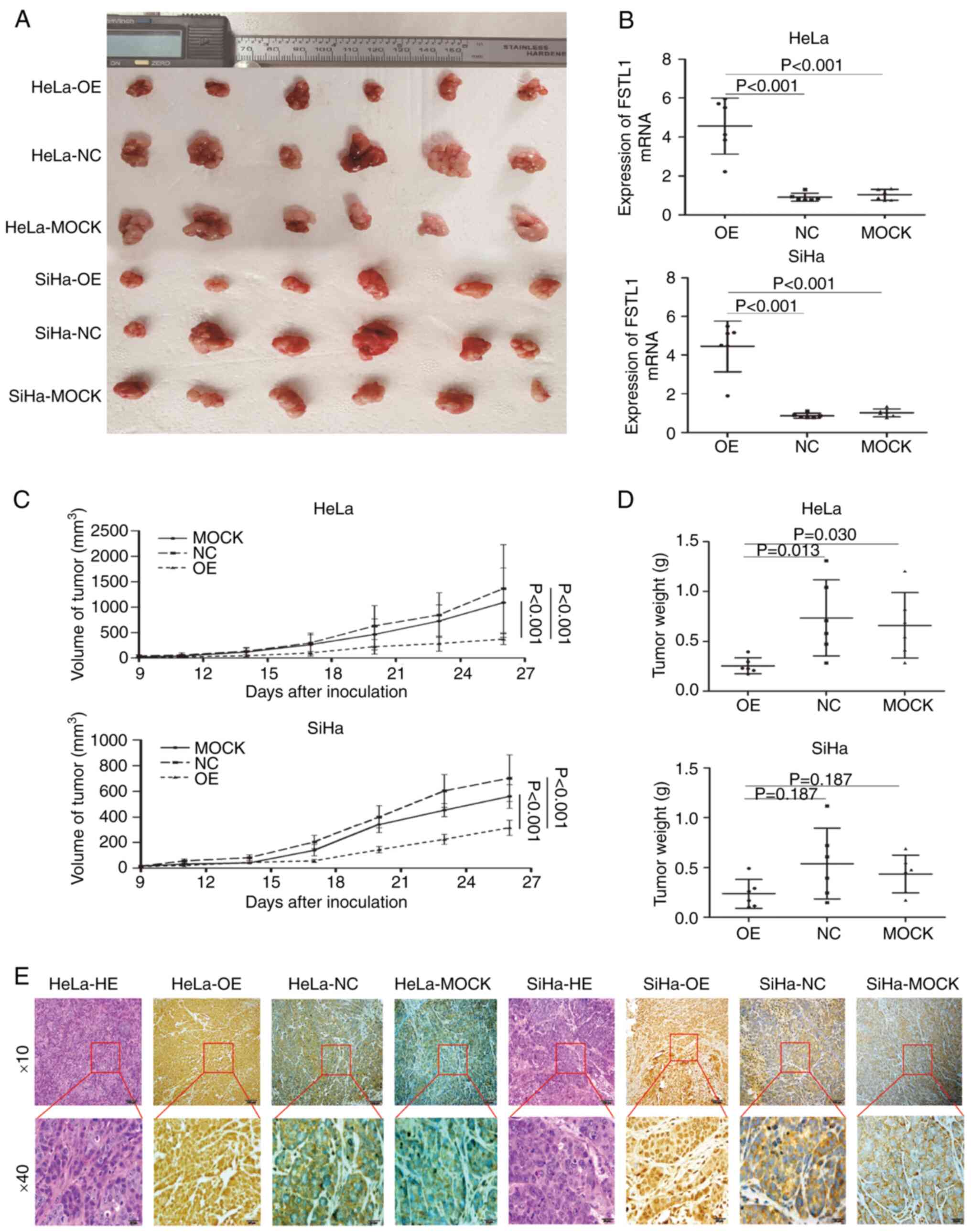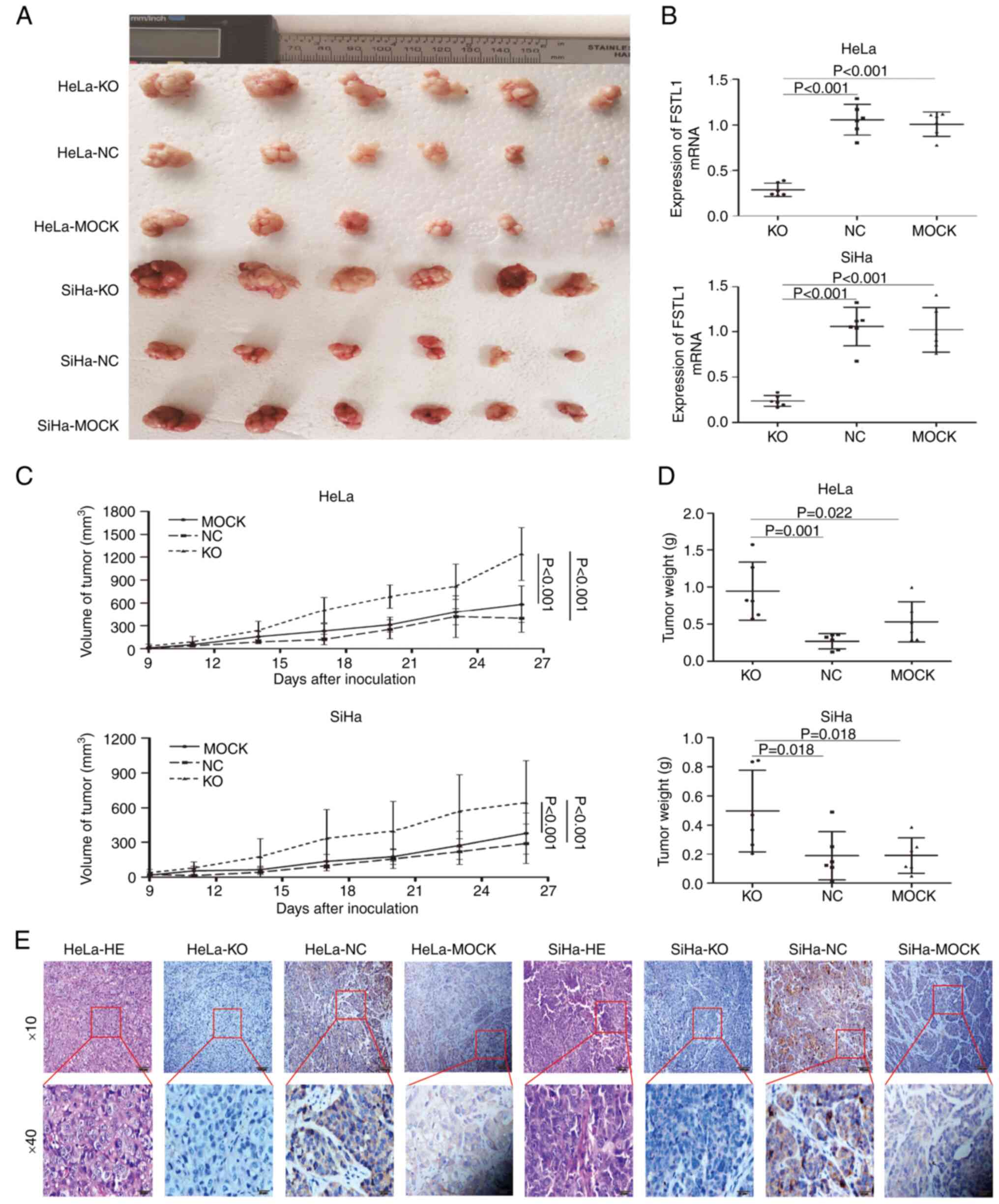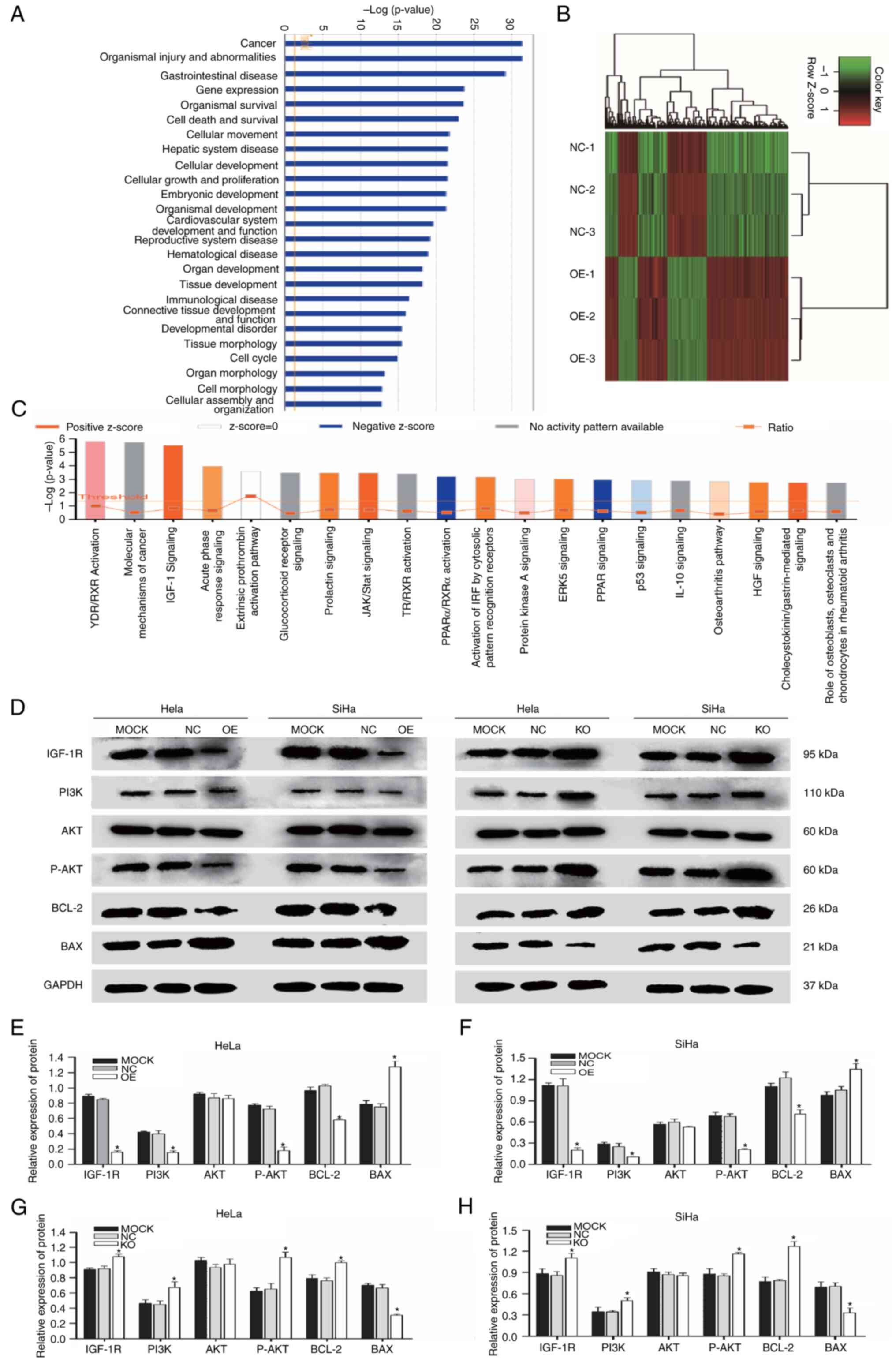|
1
|
Ferlay J, Colombet M, Soerjomataram I,
Mathers C, Parkin DM, Piñeros M, Znaor A and Bray F: Estimating the
global cancer incidence and mortality in 2018: GLOBOCAN sources and
methods. Int J Cancer. 144:1941–1953. 2019. View Article : Google Scholar : PubMed/NCBI
|
|
2
|
Lei J, Ploner A, Elfström KM, Wang J, Roth
A, Fang F, Sundström K, Dillner J and Sparén P: HPV vaccination and
the risk of invasive cervical cancer. N Engl J Med. 383:1340–1348.
2020. View Article : Google Scholar : PubMed/NCBI
|
|
3
|
Di Domenico M, Giovane G, Kouidhi S, Iorio
R, Romano M, De Francesco F, Feola A, Siciliano C, Califano L and
Giordano A: HPV epigenetic mechanisms related to oropharyngeal and
cervix cancers. Cancer Biol Ther. 19:850–857. 2018. View Article : Google Scholar : PubMed/NCBI
|
|
4
|
Mattiotti A, Prakash S, Barnett P and van
den Hoff MJB: Follistatin-like 1 in development and human diseases.
Cell Mol Life Sci. 75:2339–2354. 2018. View Article : Google Scholar : PubMed/NCBI
|
|
5
|
Bradshaw AD: Diverse biological functions
of the SPARC family of proteins. Int J Biochem Cell Biol.
44:480–488. 2012. View Article : Google Scholar : PubMed/NCBI
|
|
6
|
Liu YK, Jia YJ, Liu SH and Ma J: FSTL1
increases cisplatin sensitivity in epithelial ovarian cancer cells
by inhibition of NF-κB pathway. Cancer Chemother Pharmacol.
87:405–414. 2021. View Article : Google Scholar : PubMed/NCBI
|
|
7
|
Ni X, Cao X, Wu Y and Wu J: FSTL1
suppresses tumor cell proliferation, invasion and survival in
non-small cell lung cancer. Oncol Rep. 39:13–20. 2018.PubMed/NCBI
|
|
8
|
Liu Y, Han X, Yu Y, Ding Y, Ni C, Liu W,
Hou X, Li Z, Hou J, Shen D, et al: A genetic polymorphism affects
the risk and prognosis of renal cell carcinoma: Association with
follistatin-like protein 1 expression. Sci Rep. 6:266892016.
View Article : Google Scholar : PubMed/NCBI
|
|
9
|
Wang H, Huang S, Wu S, Yin S, Tang A and
Wen W: Follistatin-like protein-1 upregulates dendritic cell-based
immunity in patients with nasopharyngeal carcinoma. J Interferon
Cytokine Res. 37:494–502. 2017. View Article : Google Scholar : PubMed/NCBI
|
|
10
|
Lau MCC, Ng KY, Wong TL, Tong M, Lee TK,
Ming XY, Law S, Lee NP, Cheung AL, Qin YR, et al: FSTL1 promotes
metastasis and chemoresistance in esophageal squamous cell
carcinoma through NFκB-BMP signaling cross-talk. Cancer Res.
77:5886–5899. 2017. View Article : Google Scholar : PubMed/NCBI
|
|
11
|
Wu M, Ding Y, Wu N, Jiang J, Huang Y,
Zhang F, Wang H, Zhou Q, Yang Y, Zhuo W and Teng L: FSTL1 promotes
growth and metastasis in gastric cancer by activating AKT related
pathway and predicts poor survival. Am J Cancer Res. 11:712–728.
2021.PubMed/NCBI
|
|
12
|
Su S, Parris AB, Grossman G, Mohler JL,
Wang Z and Wilson EM: Up-regulation of follistatin-like 1 by the
androgen receptor and melanoma antigen-A11 in prostate cancer.
Prostate. 77:505–516. 2017. View Article : Google Scholar : PubMed/NCBI
|
|
13
|
Yang W, Wu Y, Wang C, Liu Z, Xu M and
Zheng X: FSTL1 contributes to tumor progression via attenuating
apoptosis in a AKT/GSK-3β-dependent manner in hepatocellular
carcinoma. Cancer Biomark. 20:75–85. 2017. View Article : Google Scholar : PubMed/NCBI
|
|
14
|
Zhao C, Chen Z, Zhu L, Miao Y, Guo J, Yuan
Z, Wang P, Li L and Ning W: The BMP inhibitor follistatin-like 1
(FSTL1) suppresses cervical carcinogenesis. Front Oncol.
13:11000452023. View Article : Google Scholar : PubMed/NCBI
|
|
15
|
Liu W, Gao G, Hu X, Wang Y, Schwarz JK,
Chen JJ, Grigsby PW and Wang X: Activation of miR-9 by human
papillomavirus in cervical cancer. Oncotarget. 5:11620–11630. 2014.
View Article : Google Scholar : PubMed/NCBI
|
|
16
|
Livak KJ and Schmittgen TD: Analysis of
relative gene expression data using real-time quantitative PCR and
the 2(−Delta Delta C(T)) method. Methods. 25:402–408. 2001.
View Article : Google Scholar : PubMed/NCBI
|
|
17
|
Wang J, Zhang S, Wu J, Lu Z, Yang J, Wu H,
Chen H, Lin B and Cao T: Clinical significance and prognostic value
of SOX7 expression in liver and pancreatic carcinoma. Mol Med Rep.
16:499–506. 2017. View Article : Google Scholar : PubMed/NCBI
|
|
18
|
Battle A, Khan Z, Wang SH, Mitrano A, Ford
MJ, Pritchard JK and Gilad Y: Genomic variation. Impact of
regulatory variation from RNA to protein. Science. 347:664–667.
2015. View Article : Google Scholar : PubMed/NCBI
|
|
19
|
Laurent JM, Vogel C, Kwon T, Craig SA,
Boutz DR, Huse HK, Nozue K, Walia H, Whiteley M, Ronald PC and
Marcotte EM: Protein abundances are more conserved than mRNA
abundances across diverse taxa. Proteomics. 10:4209–4212. 2010.
View Article : Google Scholar : PubMed/NCBI
|
|
20
|
Cevenini A, Orrù S, Mancini A, Alfieri A,
Buono P and Imperlini E: Molecular signatures of the insulin-like
growth factor 1-mediated epithelial-mesenchymal transition in
breast, lung and gastric cancers. Int J Mol Sci. 19:24112018.
View Article : Google Scholar : PubMed/NCBI
|
|
21
|
Rigiracciolo DC, Nohata N, Lappano R,
Cirillo F, Talia M, Scordamaglia D, Gutkind JS and Maggiolini M:
IGF-1/IGF-1R/FAK/YAP transduction signaling prompts growth effects
in triple-negative breast cancer (TNBC) cells. Cells. 9:10102020.
View Article : Google Scholar : PubMed/NCBI
|
|
22
|
Laron Z and Werner H: Congenital IGF-1
deficiency protects from cancer: Lessons from Laron syndrome.
Endocr Relat Cancer. 30:e2203942023. View Article : Google Scholar : PubMed/NCBI
|
|
23
|
Kwon H, Choi M, Ahn Y, Jang D and Pak Y:
Flotillin-1 palmitoylation turnover by APT-1 and ZDHHC-19 promotes
cervical cancer progression by suppressing IGF-1 receptor
desensitization and proteostasis. Cancer Gene Ther. 30:302–312.
2023. View Article : Google Scholar : PubMed/NCBI
|
|
24
|
Sun L, Yuan W, Wen G, Yu B, Xu F, Gan X,
Tang J, Zeng Q, Zhu L, Chen C and Zhang W: Parthenolide inhibits
human lung cancer cell growth by modulating the IGF-1R/PI3K/Akt
signaling pathway. Oncol Rep. 44:1184–1193. 2020. View Article : Google Scholar : PubMed/NCBI
|
|
25
|
Wang C, Sun Y, Cong S and Zhang F:
Insulin-like growth factor-1 promotes human uterine leiomyoma cell
proliferation via PI3K/AKT/mTOR pathway. Cells Tissues Organs.
212:194–202. 2023. View Article : Google Scholar : PubMed/NCBI
|
|
26
|
Solarek W, Koper M, Lewicki S, Szczylik C
and Czarnecka AM: Insulin and insulin-like growth factors act as
renal cell cancer intratumoral regulators. J Cell Commun Signal.
13:381–394. 2019. View Article : Google Scholar : PubMed/NCBI
|
|
27
|
Liu Y, Zheng P, Jiao T, Zhang M, Wu Y,
Zhang X, Wang S and Zhao Z: Paiteling induces apoptosis of cervical
cancer cells by down-regulation of the E6/E7-Pi3k/Akt pathway: A
network pharmacology. J Ethnopharmacol. 305:1160622023. View Article : Google Scholar : PubMed/NCBI
|
|
28
|
Ma Y, Chen X, Ding T, Zhang H, Zhang Q,
Dai H, Zhang H, Tang J and Wang X: KAT7 promotes radioresistance
through upregulating PI3K/AKT signaling in breast cancer. J Radiat
Res. 64:448–456. 2023. View Article : Google Scholar : PubMed/NCBI
|
|
29
|
Mao YP, Song YM, Pan SW, Li N, Wang WX,
Feng BB and Zhang JH: Effect of codonopsis radix and polygonati
rhizoma on the regulation of the IRS1/PI3K/AKT signaling pathway in
type 2 diabetic mice. Front Endocrinol (Lausanne). 13:10685552022.
View Article : Google Scholar : PubMed/NCBI
|
|
30
|
Zhou WW, Dai C, Liu WZ, Zhang C, Zhang Y,
Yang GS, Guo QH, Li S, Yang HX and Li AY: Gentianella acuta
improves TAC-induced cardiac remodelling by regulating the Notch
and PI3K/Akt/FOXO1/3 pathways. Biomed Pharmacother. 154:1135642022.
View Article : Google Scholar : PubMed/NCBI
|
|
31
|
Tian Q, Guo Y, Feng S, Liu C, He P, Wang
J, Han W, Yang C, Zhang Z and Li M: Inhibition of CCR2 attenuates
neuroinflammation and neuronal apoptosis after subarachnoid
hemorrhage through the PI3K/Akt pathway. J Neuroinflammation.
19:3122022. View Article : Google Scholar : PubMed/NCBI
|
|
32
|
Yoon JH, Shin JW, Pham TH, Choi YJ, Ryu
HW, Oh SR, Oh JW and Yoon DY: Methyl lucidone induces apoptosis and
G2/M phase arrest via the PI3K/Akt/NF-κB pathway in
ovarian cancer cells. Pharm Biol. 58:51–59. 2020. View Article : Google Scholar : PubMed/NCBI
|
|
33
|
Tan X, Gong L, Li X, Zhang X, Sun J, Luo
X, Wang Q, Chen J, Xie L and Han S: Promethazine inhibits
proliferation and promotes apoptosis in colorectal cancer cells by
suppressing the PI3K/AKT pathway. Biomed Pharmacother.
143:1121742021. View Article : Google Scholar : PubMed/NCBI
|
|
34
|
Mishra S, Cosentino C, Tamta AK, Khan D,
Srinivasan S, Ravi V, Abbotto E, Arathi BP, Kumar S, Jain A, et al:
Sirtuin 6 inhibition protects against glucocorticoid-induced
skeletal muscle atrophy by regulating IGF/PI3K/AKT signaling. Nat
Commun. 13:54152022. View Article : Google Scholar : PubMed/NCBI
|
|
35
|
Chen L, Qing J, Xiao Y, Huang X, Chi Y and
Chen Z: TIM-1 promotes proliferation and metastasis, and inhibits
apoptosis, in cervical cancer through the PI3K/AKT/p53 pathway. BMC
Cancer. 22:3702022. View Article : Google Scholar : PubMed/NCBI
|
|
36
|
Zhang X, Qu P, Zhao H, Zhao T and Cao N:
COX-2 promotes epithelial-mesenchymal transition and migration in
osteosarcoma MG-63 cells via PI3K/AKT/NF-κB signaling. Mol Med Rep.
20:3811–3819. 2019.PubMed/NCBI
|
|
37
|
Siddiqui WA, Ahad A and Ahsan H: The
mystery of BCL2 family: Bcl-2 proteins and apoptosis: An update.
Arch Toxicol. 89:289–317. 2015. View Article : Google Scholar : PubMed/NCBI
|
|
38
|
Hers I, Vincent EE and Tavaré JM: Akt
signalling in health and disease. Cell Signal. 23:1515–1527. 2011.
View Article : Google Scholar : PubMed/NCBI
|















